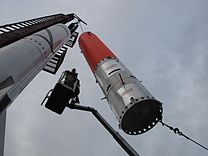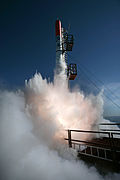- Copenhagen Suborbitals
-
Coordinates: 55°41′29.1″N 12°37′1.21″E / 55.691417°N 12.6170028°E


Type Non Profit Industry Astronautics Founded May 1, 2008 Headquarters Refshaleøen, Copenhagen, Denmark Key people Peter Madsen (Founder)
Kristian von Bengtson (Founder)Products Sub-orbital spaceflight
Rocket launchEmployees > 22 - All volunteering [1] Website www.copenhagensuborbitals.com Copenhagen Suborbitals is a suborbital space endeavor, based entirely on private donors, sponsors and part time specialists. Their mission is to launch human beings into space on privately-built rockets and spacecrafts.The project is both open source and non-profit in order to inspire as many people as possible, and to involve relevant partners and their expertise. They aim to show the world that human space flight can be different from the usual expensive and government controlled project. They also are working full time to develop a series of suborbital space vehicles - designed to pave the way for manned space flight on a micro-sized spacecraft. The mission has a 100% peaceful purpose and is not in any way involved in carrying explosive, nuclear, biological and chemical payloads. They intend to share all of their technical information as much as possible, within the laws of EU-export control.[2]
Contents
Key Personnel
Founders
- Kristian von Bengtson, responsible for the design and construction of the spacecrafts. He is an architect and has participated in various space projects, design of new moon rovers and co-author of NASA's new design manual HIDH.[3][4][5][6]
- Peter Madsen, responsible for the rocket engines. He is an inventor, artist and entrepreneur. Before forming CS, he built 3 submarines; Freya (2002), Kraka (2005) and UC3 Nautilus (2008).[7]
Specialists
- Thomas Scherrer, Spacecraft electronics, comm-link.
- Claus Nørregaard, Certified pyrotechnician.
- Christian Ravn, Physicist
- Niels Foldager, Space medicine, Dept. Flight Director.
- Kristian Elof Sørensen, MLP-Sputnik Captain.
- André Christensen, Recovery lead and Area control.
In total, the group includes, as of Aug 2011, 22 people with various skills.[8]
The basic plan
A rocket, will carry the MSC (the micro-spacecraft) above the 100 km boundary and into space. Gravity will then pull the MicroSpaceCraft back to the atmosphere, where the MSC will land on water using parachutes.[9] If successful, Denmark will be the fourth nation to launch humans into space, after Russia, USA and China.[10] Peter Madsen is scheduled for the flight, then Kristian von Bengtson will attempt a low earth orbit mission.
Rocket engines
Propellant
The Group has decided to use a hybrid rocket, using LOX as oxidizer and originally HEAT was to have been fuelled with paraffin wax, but a ground test 28 February 2010 revealed that some of the paraffin wax had only partially melted, instead of evaporating. The result was that HEAT-1X had less power than expected. A ground test firing of HEAT-1X-P (P for polyurethane) was conducted 16 May 2010. It was positive, the polyurethane had the right power but showed heavy oscillation. A complete list of ground test can be found here
HATV (Hybrid Atmospheric Test Vehicle)
The HATV is a powerful, yet crude, 220 mm diameter hybrid booster. It produces some 12 kN thrust with a combustion time of 20 seconds. The HATV rocket is 1/3 size of the final rocket, HEAT.
HEAT (Hybrid Exo Atmospheric Transporter)
Main article: HEAT 1X Tycho Brahe Drawing of the stacked rocket, with HEAT at the bottom.
Drawing of the stacked rocket, with HEAT at the bottom.
HEAT 1X Tycho Brahe[11] is a rocket and spacecraft project which is being built by Copenhagen Suborbitals, a Danish organization attempting to perform the first amateur manned spaceflight.
MicroSpaceCraft
Tycho Brahe
Main article: HEAT 1X Tycho BraheThe first ship type is named after Tycho Brahe
MAX-1
Main article: MAX-1 (Spacecraft)The second ship type is named after Maxime Faget
Launch campaigns
The Group originally focused on launching from a land based Spaceport like Andøya, Kiruna or Iceland[12] The focus however turned towards a sea launch, just outside the territorial waters of Denmark. A permission to launch was given by Danish authorities, but the first option, the North Sea, a possibility that the Danish Civil Aviation Administration (Statens Luftfartsvæsen) suggested, was rejected in 2009 by the Danish Maritime Authority (Søfartsstyrelsen). They preferred another area and then gave a formal and written permission to launch from the military firing range ESD138/ESD139, it is located on the position 55°02′57″N 15°36′11″E / 55.04917°N 15.60306°E in the Baltic Sea. It is just outside Nexø on the Danish island of Bornholm and are therefore nicknamed Spaceport Nexø. The rocket group then had to build a floating MLP, they did and called it Sputnik. Their launch campaigns includes the following ships:
- MLP-Sputnik, at first had to be towed, but later it had two diesel engines installed, and now sails under her own power.
- MHV Hjortø, a Naval Home Guard vessel who serves as Mission Control and recovery vessel.
- Two small RIHBS.
2010: HEAT 1X Tycho Brahe
The first full-scale test-launch to 30 km was planned to be off the coast of Bornholm between 30 August and 13 September 2010.[13] The vehicle carried a crash test dummy "Rescue Randy" instead of a human pilot, with manned flight still some years away. The success criteria was the completion of the sea voyage and countdown with launch and recovery planned as a bonus.[14]
On Tuesday 31 August 2010, the privately-built Danish submarine UC3 Nautilus pushed the launch platform Sputnik carrying the rocket and spacecraft from Copenhagen towards the launch area near Nexø, Bornholm.[15]
A launch attempt was made on Sunday 5 September 2010 14:43 CEST,[16] but the motor could not be started due to a failure of the LOX valve which is assumed to be caused by insufficient heating of the valve.
The Group promised to come back the year after to attempt the launch again.[17]
2011: HEAT 1X Tycho Brahe
Having done updates on the rocket, and the valve, MLP-Sputnik, now under her own power, and a support vessel, sailed again for Spaceport Nexø on May 28th at 04:50 a.m. They again met up with MHV Hjortø, a Naval Home Guard vessel who serves as Mission Control and recovery vessel. The second launch attempt was more successful and the maiden flight took place 3 June 2011, at 10:32 a.m. EDT (14:32 GMT), 16:32 CEST (local time). The Heat-1X rocket lifted off and ascended to an altitude of only 2.8 km, because Mission Control had to shut the engine off after 21 seconds.[18] Although there were problems with the parachutes, the Tycho Brahe was recovered and the flight produced useful data for subsequent development of the program.
Future plans and concept vehicles
Orbit Capsule with LES Tower
The Group has announced, they will build an Orbit capsule and an LES tower. A test launch is planned for the summer of 2012.[19]
Other plans include:
- LEO (Low Earth Orbit): The group has expressed interest in doing a LEO mission some time in the future.
- SuperMLP: The group has talked about building a bigger sea launch platform, to accommodate bigger rockets and longer sea travels.
- Super HEAT: The group has mentioned the possibility to cluster seven HEAT rockets, to be able to lift more payload (Like the orbit Capsule and LES tower).
- Liquid propellant Engines: The rocket group has performed some small scale testing.
Facilities
CS started on a barge called M/S Halfmachine in Port of Copenhagen. On 1 August 2009 they relocated to its base and office on Refshaleøen, the old Burmeister & Wain shipyard, in Copenhagen. Their main workshop is in the HAB (Horisontal Assembly Building) and they have recently added a VAB to their structures.
Goals and records achieved
Some of the things Copenhagen Suborbitals have achieved so far is:
- Most powerful amateur rocket ever flown.[20]
- First amateur rocket flown with a payload of a full size Crash test dummy.[20]
- First Main Engine(s) Cut-Off (MECO) command sent to, received and performed by an amateur rocket.[20]
- They have proved to themselves, and everybody else, that they can orchestrate and handle a sea launch.
Support group
By October 2010 a fundraising organisation with some 220 paying members was started. CS decided early that many small sponsors, joining just for fun, were better than a main sponsor with demands and pressure.[21] As of July 7 there are 483 members, the Members of Copenhagen Suborbitals Support now pays the fixed costs of continuing the project.[22]
References
- ^ http://www.copenhagensuborbitals.com/faq.php
- ^ http://www.copenhagensuborbitals.com/mission.php Mission Statement from Copenhagen Suborbitals website
- ^ Connolly, Janis et al. Human Integration Design Handbook (HIDH) NASA, 27 January 2010. Retrieved: 5 September 2010.
- ^ http://ing.dk/artikel/87969-dansk-arkitektur-skal-forhindre-hallucinationer-i-rumfartoejer Ingeniøren.dk's homepage. Article about architecture in space living. Danish language.
- ^ Bibliography Space Architect. Retrieved: 5 September 2010.
- ^ Members Space Architect. Retrieved: 5 September 2010.
- ^ http://www.uc3nautilus.dk/ UC3 Nautilus's webpage.
- ^ http://www.copenhagensuborbitals.com/personel.php Copenhagen Suborbitals homepage.
- ^ http://www.copenhagensuborbitals.com/spacecraft.php Copenhagen Suborbitals homepage. Retrieved 14 February 2010.
- ^ Danish Volunteers Build Manned Spacecraft Retrieved August 25th 2010
- ^ "Spacecraft". Copenhagen Suborbitals. http://www.copenhagensuborbitals.com/spacecraft.php. Retrieved 8 September 2010.
- ^ http://translate.google.com/translate?js=n&prev=_t&hl=en&ie=UTF-8&layout=2&eotf=1&sl=da&tl=en&u=http%3A%2F%2Fing.dk%2Fartikel%2F97766-ground-launch-site-den-onde-joker&act=url Translated Danish blog
- ^ http://www.copenhagensuborbitals.com/campaign.php Copenhagen Suborbitals homepage. Retrieved 29 August 2010.
- ^ Andersen, Kasper Brøndgaard. Experienced rocket builder doubts success Ing.dk (Danish), 31 August 2010. Retrieved: 31 August 2010.
- ^ Jensen, Mette Buck. Reaching Nexø Ing.dk (Danish), 1 September 2010. Retrieved: 1 September 2010. Pictures
- ^ [1] Ing.dk, 5 September 2010. Retrieved: 5 September 2010.
- ^ http://ing.dk/artikel/111713-vi-er-stolte-vi-er-glade-vi-gir-aldrig-op
- ^ Astrup, Søren; Lindqvist, Andreas (2011-06-03). "Flyt jer lige lidt, Nasa: Her kommer Danmark" (in Danish). Politiken. http://politiken.dk/videnskab/ECE1299139/flyt-jer-lige-lidt-nasa-her-kommer-danmark/. Retrieved 2011-06-03.
- ^ http://ing.dk/artikel/120473-copenhagen-suborbitals-nye-bonus-projekt-2-meter-orbit-kapsel-med-les-motor/ Blog describing the LES projekt (Danish)
- ^ a b c http://translate.googleusercontent.com/translate_c?hl=en&rurl=translate.google.com&sl=da&tl=en&u=http://www.raketvenner.dk/&usg=ALkJrhimfHbhIK5Q5Vs8350aoUfHrAA3bQ
- ^ Jensen, Mette Buck. Only money for rent this year Ing.dk, 22 September 2010. Retrieved: 22 September 2010.
- ^ http://raketvenner.dk/ Copenhagen Suborbitals Support homepage.
External links
- Copenhagen Suborbitals official website
- Danish blog written by the people of Copenhagen Suborbitals
- Copenhagen Suborbitals Support
- HEAT1X-Tycho launch highlights on YouTube
- Lecture by Kristian von Bengtson, from TEDx
Copenhagen Suborbitals Human spaceflight
programsCurrentHEAT 1X Tycho Brahe · MAX-1FuturePossible orbital mission
Key People Peter Madsen · Kristian von BengtsonSpace tourism Companies Armadillo Aerospace · Bigelow Aerospace · Blue Origin · EADS Astrium · Mojave Aerospace Ventures · Orbital Sciences Corporation · RocketShip Tours · Scaled Composites · Space Adventures · SpaceX · Virgin Galactic · XCOR Aerospace
Organizations ARCA · Association of Autonomous Astronauts · Astronaute Club Européen · Commercial Spaceflight Federation · Copenhagen Suborbitals · Space Frontier Foundation · Space Tourism SocietySuccessful spacecraft Living in space Space competitions Spaceflight General 
Applications Earth observation satellites (Spy satellites · Weather satellites) · Private spaceflight · Satellite navigation · Space archaeology · Space architecture · Space colonization · Space exploration · Space medicine · Space tourismHuman spaceflight GeneralHazardsMajor projectsApollo · Constellation · Gemini · International Space Station · Mercury · Mir · Shenzhou · Soyuz · Space Shuttle · Voskhod · VostokSpacecraft Destinations Space launch Space agencies Categories:- Companies established in 2008
- Non-profit organisations based in Denmark
- Organizations based in Copenhagen
- Private spaceflight companies
- Space non-governmental organizations
- Spaceflight
Wikimedia Foundation. 2010.





